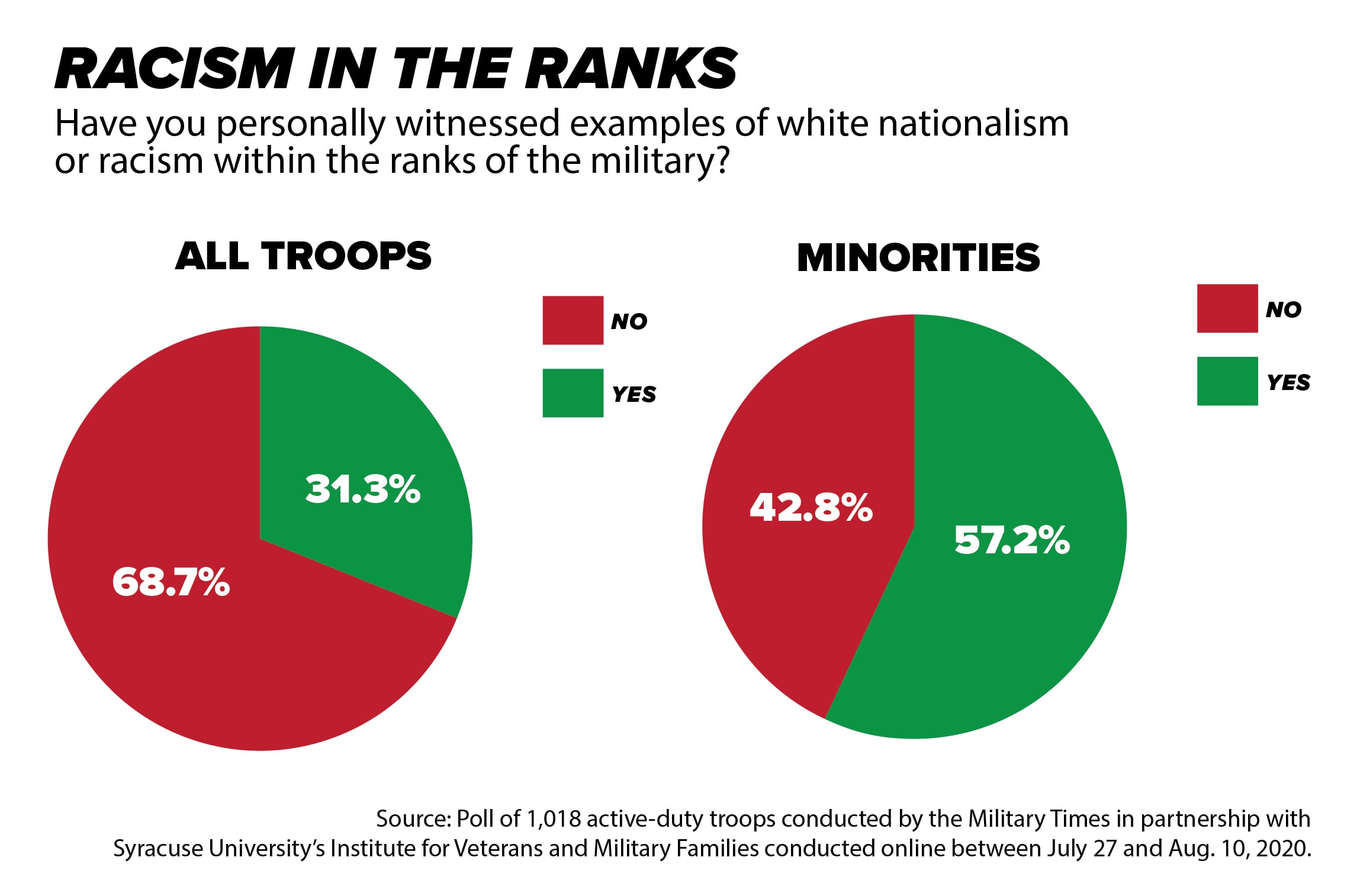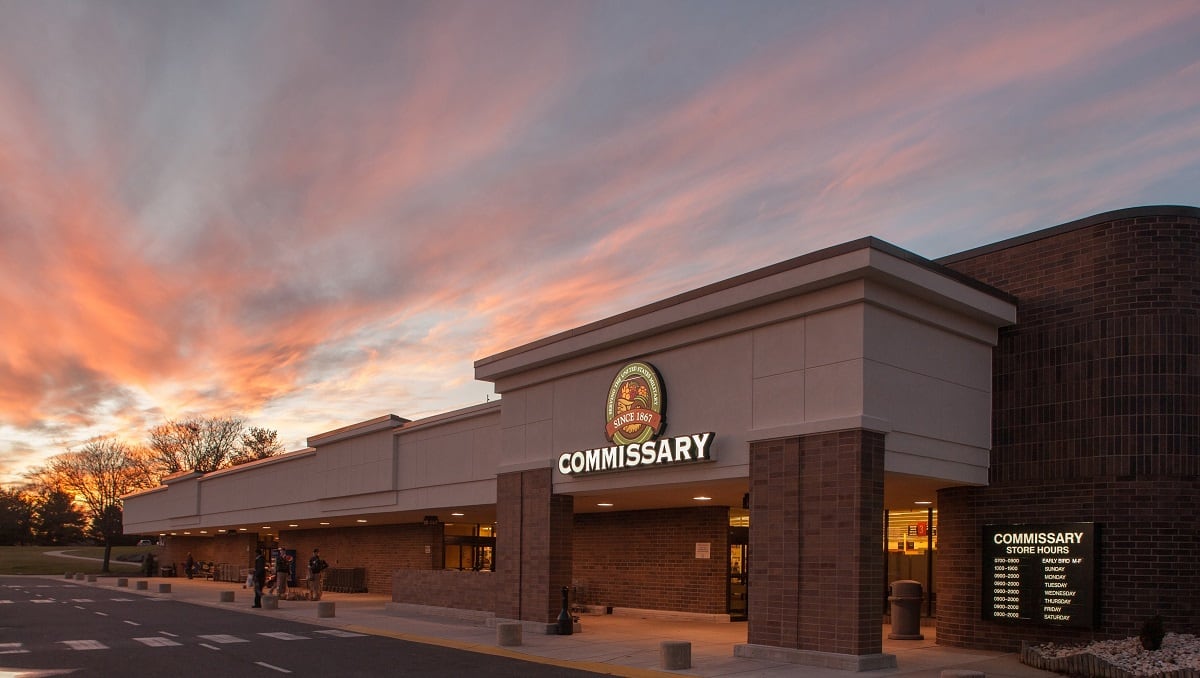Troops surveyed in the latest Military Times Poll identified white nationalism as a national security threat on par with al-Qaida and the Islamic State Group, and more worrisome than the danger posed by North Korea, Afghanistan or Iraq.
Participants, polled in late July after months of nationwide racial equality protests and violent conflicts between demonstrators and law enforcement, also reported signs of racist behavior in the ranks, despite military leaders’ recent reminders of the importance of diversity and respect.
The poll, conducted in partnership with the Institute for Veterans and Military Families (IVMF) at Syracuse University, found about one-third of all active-duty respondents said they saw signs of white supremacist or racist ideology in the ranks. That’s roughly on par with results from other Military Times surveys in recent years.

But troops overall concerns about the dangers posed to the country from extremist and racist ideology appears to be growing. Among all troops surveyed, about 48 percent listed white nationalists as a significant national security threat, roughly the same percentage as Islamic State, al-Qaida and other foreign Islamic jihadists.
The white nationalist problem overshadowed troops’ worries over North Korea (40.3 percent), Afghanistan (10.3 percent), Iraq (8.5 percent), immigration (21.4 percent) and U.S. protest movements (33.1 percent). Nearly two-thirds of minority service members in the poll called white nationalists a notable threat.
RELATED

About 5 percent of troops in the poll said they have participated in protests in recent months which followed the death of George Floyd, a Black Minneapolis man who prosecutors say was murdered by a white Minneapolis police officer during an arrest on non-violent charges on May 25. Respondents did not specify if they were protesting in support of police reforms or against such moves.
Rep. Anthony Brown, D-Md., an Iraq War veteran who has been a critic of past Pentagon efforts to tackle issues of racial equality and discrimination in the ranks, said he is encouraged that more service members seem to be recognizing the threat that racist ideology poses to the country, but he remains concerned that military leaders haven’t done enough to address the problem in their own ranks.
Roughly 31 percent of troops said they have seen signs of extremist behavior in the military. That’s down about 5 percent from a similar poll question in late 2019 but above the 23 percent mark when Military Times began asking the question in 2017.
About 57 percent of minority troops polled said they have personally experienced some form of racist or white supremacist behavior. That’s up nearly 4 percent from the poll conducted last fall.

“I don’t think we’re making progress on this issue. Clearly the survey says that we’re not,” Brown said. “This problem doesn’t represent who the military is and what we want to represent, but it is present.”
Poll respondents reported examples such as peers displaying white nationalist tattoos, making racist statements or participating in online forums linked to hate groups.
“I’ve seen multiple soldiers online disrespecting the Black Lives Matter movement and the plight of people of color in our nation,” wrote one poll respondent. “I have seen leadership on multiple occasions say that the protesters should be shot, that our president should be more violent when dealing with the protesters. I’m disgusted.”
Others said they heard frequent use of racial slurs from white peers, both in conversations where they thought minorities weren’t present or in loud, public comments which seemed to invite confrontation.
“Peers have been very vocal on how they believe that George Floyd deserved his death and are quick to point out black on black crime,” wrote another poll participant. “They complain that every ethnicity has an observance month but have nothing to celebrate ‘white pride.’”
RELATED

Defense Department officials have questioned the poll findings and the prevalence of the problem in the past, but lawmakers have criticized them for a lack of similar internal polling to fully gauge the problem. Pentagon officials did not respond to request for comment on the latest poll findings.
Brown is optimistic that will be addressed this year. Included the House’s draft of the annual defense authorization bill is language to better track all instances of extremist activities in the ranks, and plans to include a question similar to the Military Times poll in command climate surveys.
“I think there are a lot of well-intentioned people (in military leadership) who would like for there to be no white nationalism, no white supremacists in the military, but they don’t seem willing to make the effort to make a change,” he said.
“We don’t know the full extent of the problem now … Instead of just a sample of the military, every single person in uniform needs to be asked about this. And it’s not just for leadership. At the unit level, commanders will be able to see if they have a problem and address it immediately.”
RELATED

Our methodology
Between July 27 and Aug. 10, Military Times in collaboration with the Institute for Veterans and Military Families at Syracuse University conducted a voluntary, confidential online survey of U.S. service members. Poll participants are readers of Military Times publications whose military status is verified through official Defense Department email addresses.
The survey included about 30 questions on service members’ opinions related to the current political climate, policy and national security in the United States.
The survey received 1,018 responses from active-duty troops. The IVMF used standard methodology to weight the results according to the rank, gender and service branch of the actual U.S. military. The margin of error for most questions was less than 2 percent.
Like most studies where participation is voluntary, the poll’s sample is subject to self-selection bias. Researchers sought to account for that and adhered to generally accepted scientific practices analyzing the data.
The survey audience was 93 percent male and 7 percent female. The respondents identified themselves as 82 percent white, 5 percent Hispanic, 6 percent African American, 2 percent Asian and 6 percent other ethnicities. Respondents were able to select more than one race.
The Military Times and the researchers at IVMF have used identical methodologies for this survey since 2016.
Leo covers Congress, Veterans Affairs and the White House for Military Times. He has covered Washington, D.C. since 2004, focusing on military personnel and veterans policies. His work has earned numerous honors, including a 2009 Polk award, a 2010 National Headliner Award, the IAVA Leadership in Journalism award and the VFW News Media award.




